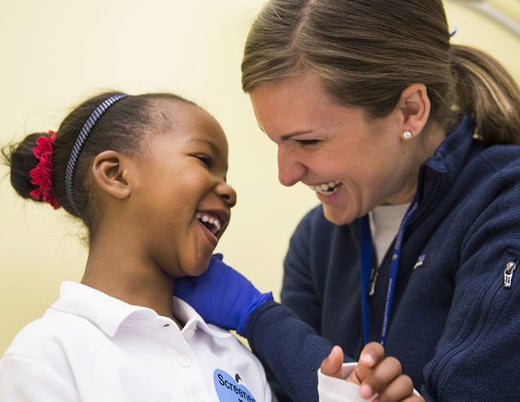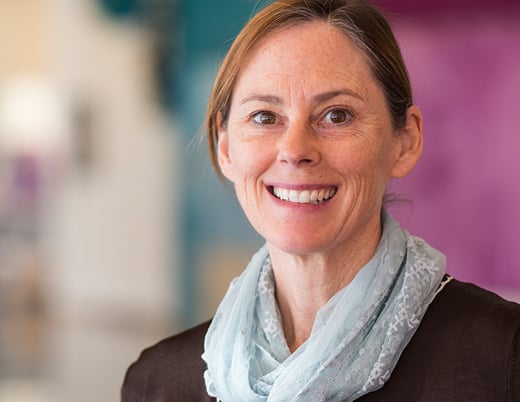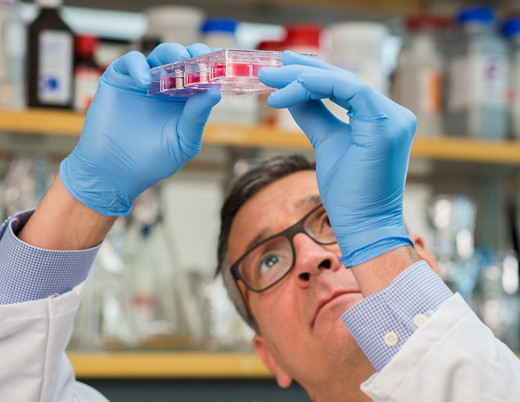How do you perform a bone marrow transplant without using red blood cells from a third-party match?
The patient, a 15-month-old, has two rare disorders. Primarily, chronic granulomatous disease, or CGD, an immunodeficiency disease that affects the body’s ability to protect against bacterial infection. Secondarily, McLeod syndrome, a neurological disorder that causes abnormal red blood cells and potentially impairs cardiovascular and nervous system function. The cure for CGD is a bone marrow transplant, but McLeod syndrome makes it nearly impossible to find a compatible blood donor to support the transplant. How do you proceed? … Or do you?
The patient had initially presented with appendicitis, which was uncommon due to the patient’s age. In the months that followed the appendectomy, the patient had high fevers and a swollen cervical lymph node. The patient was admitted to Children’s Hospital Colorado due to throat swelling and was intubated. Doctors ran multiple tests, including a review of fluid from the lymph node, which showed an overgrowth of the rare bacteria Nocardia.
“We’re very fortunate to have comprehensive in-house immunodiagnostics,” says Children’s Colorado pediatric hematologist Chris McKinney, MD. “A subsequent blood test revealed that the patient’s neutrophils lacked a normal respiratory burst as measured by DHR, indicative of CGD.”
Genetic testing ultimately revealed that the patient also had McLeod syndrome.
Children’s Colorado has the largest CGD cohort in the region, about 14 patients. “We’ve transplanted four of them in the last year,” adds Dr. McKinney. CGD patients require an incredibly multidisciplinary approach, with expertise from hematology, diagnostics, infectious disease, immunology and transfusion medicine.
A nuanced bone marrow transplant
Children’s Colorado’s mass of various subspecialty expertise was critical in this patient’s case due to the compounding McLeod syndrome. The patient’s 5-year-old brother was a perfect match for a bone marrow transplant. Getting through it would require support from blood transfusions, though, and McLeod syndrome was causing the patient’s red blood cells to lack a protein that more than 99.9% of blood donors have.
“If a patient with McLeod syndrome receives blood from a donor with the missing protein, the patient can make an antibody that can destroy any future transfused red blood cells and even attack the new transplant,” says Children’s Colorado transfusion medicine specialist, Kyle Annen, DO. “The patient’s brother had normal red blood cells, so his bone marrow also carries the missing protein. Because of McLeod syndrome and the patient’s abnormal blood cells, the chance of finding an allogeneic third-party blood donor was slim.”
When this happens in adult patients, doctors can initiate what’s called an autologous donation, where the patient donates blood to themselves in advance of a surgery or other anticipated need for blood. But it’s easier and quicker to collect blood from an adult patient due to body and vein size. A so-called bloodless transfusion has never been done in a pediatric patient due to the complex freezing and thawing process it requires. Timing the blood donation can also be challenging, as a blood unit is only good for 42 days; for rare blood types, the blood can be frozen for later use. The process for freezing blood is well-established for adults but requires a specific volume of blood — more blood than a pediatric patient could tolerate losing.
Building a customized bone marrow transplant procedure
Dr. Annen reached out to her colleague Larry J. Dumont, MBA, PhD, Vice President of Research and Scientific Programs at Vitalant Research Institute’s campus extension in Denver, which offers state-of-the-art equipment to support research related to blood and blood product safety.
"Because of the patient’s size and the volume of whole blood that they could collect, we needed a customized process for low-volume freezing, deglycerolizing and preparation for transfusion,” Dr. Dumont tells a staff writer with Vitalant. “[Our team of researchers] developed and validated the process while concurrently working with Children’s Colorado clinicians to collect the patient’s blood. We were also uncertain about the fragility of these unusual and rare red blood cells and if they would stand up to the rigors of freezing and thawing.”
The patient’s McLeod syndrome is the result of what Dr. Annen calls a “genetic deletion” — when the patient is missing part of the structure of the walls of red cells, rendering them extremely fragile. “We didn’t know what that meant for the patient,” Dr. Annen says. “There was really no way to know if the red blood cells would survive until we thawed them for the patient’s actual need.”
The team discussed thawing a small sample ahead of time. But the sample may not have been representative due in part to the number of adjustments and manipulations they’d already made to the process. If the cells had been destroyed, it would be difficult to determine whether that was due to the patient’s McLeod syndrome or to an error in the thawing process. “We decided not to experiment and waste a whole unit,” Dr. Annen says, “mainly because the preceding four collections were challenging enough for the patient.”
Transplanting the patient
The team used several techniques to get the patient through the bone marrow transplant process. The first was erythropoietin, or EPO, a hormone to help the patient’s red cells recover faster afterward. They also minimized blood volumes, taking much less than they typically would for labs. Additionally, the team typically transfuses a patient with blood when their hemoglobin gets low enough, but in this case, they tolerated much more severe anemia to minimize blood transfusions.
“It’s almost unheard of for people to get through an allogeneic bone marrow transplant without needing blood from someone else — and without needing platelet transfusions either,” Dr. McKinney says. “That’s mainly due to the patient’s inability to make blood because of chemotherapy treatment, which is necessary to get rid of the old bone marrow to make space for the new bone marrow. The only reason we got through this bone marrow transplant is by having those additional blood units from the patient that Drs. Annen and Dumont were able to collect beforehand. We ended up needing two of those four bags they collected.”
The entire process, from diagnosis to transplant, took about a year and a half. Four months of blood collections from the patient and many more months prior of preplanning. It’s paid off. Nearly a year post transplant, the patient is off all medication except antibiotics for the Nocardia infection. Once the patient reaches the year mark, Dr. McKinney will be through with follow-up. The patient is gaining weight, living normally and will likely attend school in the fall.
“We extrapolated quite a bit from the existing literature on autologous transfusions for Jehovah’s Witnesses, because those patients typically do not accept third-party blood donations for religious reasons,” Dr. McKinney says. “And that’s where I think this case has broader applicability. The process of an autologous donation hasn’t been an option for pediatric patients due to the lengthy collection, freezing and thawing of the blood product, but it is now.”
Featured Researchers

Chris McKinney, MD
Pediatric hematologist-oncologist
Center for Cancer and Blood Disorders
Children's Hospital Colorado
Assistant professor
Pediatrics-Hematology/Oncology and Bone Marrow Transplantation
University of Colorado School of Medicine

Kyle Annen, DO
Medical Director of Transfusion Services
Children's Hospital Colorado
Associate professor
Pathology
University of Colorado School of Medicine





 720-777-0123
720-777-0123










